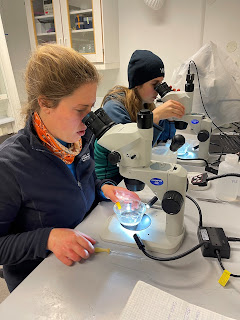Dark Knight: part 2
 |
| Sorting plankton with Kharis. Photo by Alexa Elliott, Changing Seas/South Florida PBS. |
When it rains, it pours, right? Larvae are super patchy, so you can catch almost nothing for days on end and then be swarmed with the little buggers. If you just dip your net in the right place in the ocean at the right time, you can end up with more larvae than you ever wanted. That's what happened to us.
We had taken our large plankton net on the research boat, Teisten, and towed it through the water for about 10 minutes. It didn't seem like that long, but we ended up with a super dense larval sample.
There is some good news here. First of all, sub-sampling is an option. We decided that for the most common species, we would only count them in the first part of the sample, then extrapolate to the whole sample. This strategy saved us a lot of time. Second, we finally had enough larvae to start our feeding and settlement experiments! We decided on a reduced experimental design to save time, but even with the reduced design, we could begin to figure out whether our larvae were feeding and capable of settling to the seafloor in the polar night.
I'll take too many larvae over no larvae any day - it's a good problem to have.
Comments
Post a Comment